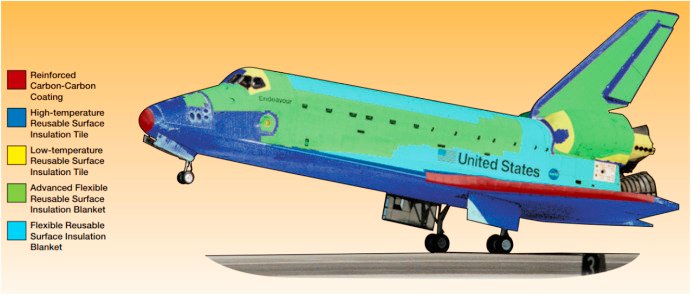Thermal Protection Systems (TPS) safeguard spacecraft during re-entry by managing the intense heat and extreme conditions encountered as the vehicle re-enters Earth’s atmosphere. These systems are engineered to protect both the spacecraft structure and any occupants or payloads from the high temperatures generated by friction, compression, and aerodynamic heating.
1. Why Is Thermal Protection Necessary?
When a spacecraft re-enters the atmosphere:
- Speed and Heat Generation:
- Speeds exceed 27,000 km/h (17,000 mph) in low-Earth orbit. As the spacecraft interacts with atmospheric particles, air is compressed and heated, reaching temperatures up to 1,650°C (3,000°F).
- Heat Transfer:
- Heat is transferred to the spacecraft through conduction, convection, and radiation.
- Structural Integrity:
- Without TPS, the spacecraft’s materials would melt, deform, or fail due to the intense heat and pressure.
2. Key Functions of a Thermal Protection System
- Heat Resistance:
- Prevent the transfer of heat into the spacecraft’s interior.
- Ablation or Reflection:
- Dissipate heat by absorbing, radiating, or shedding material.
- Structural Protection:
- Maintain the integrity of the spacecraft under thermal and mechanical stress.
- Weight Efficiency:
- Be lightweight to avoid adding unnecessary mass to the spacecraft.
3. Types of Thermal Protection Systems
a. Passive Thermal Protection Systems
Rely on materials and designs that resist or dissipate heat without mechanical or active components.
1. Ablative Heat Shields
- How They Work:
- Ablative materials absorb heat and gradually erode (ablate), carrying heat away with the vaporized material.
- Examples:
- Resin-based composites, such as phenolic-impregnated carbon ablator (PICA) and carbon-phenolic materials.
- Advantages:
- Extremely effective at handling high heat loads and reducing the risk of overheating.
- Applications:
- Used on NASA’s Apollo Command Module, Mars rovers, and Orion spacecraft.
2. Radiative Heat Shields
- How They Work:
- Materials with high emissivity radiate absorbed heat back into the atmosphere.
- Examples:
- Heat-resistant ceramics, carbon-carbon composites.
- Advantages:
- Minimizes the amount of heat transferred to the spacecraft structure.
- Applications:
- Often combined with ablative systems.
3. Refractory Materials
- How They Work:
- High-melting-point materials withstand extreme heat without melting or eroding.
- Examples:
- Silica-based tiles and reinforced carbon-carbon (RCC).
- Applications:
- Used on the Space Shuttle’s leading edges and nose cone.
b. Active Thermal Protection Systems
Use mechanical or dynamic methods to manage heat.
1. Heat Sinks
- How They Work:
- Heat is absorbed and temporarily stored in materials with high thermal capacity, then dissipated gradually.
- Examples:
- Copper and aluminum components.
- Applications:
- Rarely used in modern spacecraft due to weight limitations.
2. Heat Pumps
- How They Work:
- Move heat away from critical areas using active systems, such as liquid cooling or heat exchangers.
- Applications:
- Primarily used in spacecraft systems rather than for re-entry.
4. Materials Used in Thermal Protection Systems
a. Reinforced Carbon-Carbon (RCC)
- Properties:
- High strength, withstands temperatures up to 1,650°C (3,000°F).
- Applications:
- Space Shuttle nose cone and leading edges.
b. Ceramic Tiles
- Properties:
- Low thermal conductivity and high-temperature resistance.
- Silica-based tiles (e.g., LI-900 tiles) used on the Space Shuttle.
- Applications:
- Protect vehicle undersides from moderate heat.
c. Ablative Materials
- Properties:
- Sacrificial layers that char, vaporize, and shed to dissipate heat.
- Examples: Phenolic resins, carbon composites.
- Applications:
- Apollo capsules, Mars missions, and interplanetary entry systems.
d. Multi-Layer Insulation (MLI)
- Properties:
- Multiple reflective layers (often aluminized Mylar or Kapton) separated by spacers to minimize heat transfer.
- Applications:
- Used for thermal regulation in orbit but not for re-entry.
e. Flexible Heat Shields
- Properties:
- Made of lightweight and foldable materials for compact storage during launch.
- Applications:
- NASA’s ADEPT (Adaptive Deployable Entry and Placement Technology) concept.
5. Techniques for Heat Management
a. Controlled Re-Entry
- By carefully managing the spacecraft’s angle of descent (entry angle), engineers can minimize heat generation and structural stress.
b. Distributed Heating
- Spread heat across a larger surface area to reduce concentrated heating.
- Example: Space Shuttle tiles.
c. Blunt-Body Aerodynamics
- Blunt shapes create a shockwave that deflects heat away from the spacecraft.
- Example: Apollo Command Module and Orion capsules.
6. Applications of Thermal Protection Systems
a. Crewed Spacecraft
- Protect astronauts during atmospheric re-entry.
- Examples:
- Apollo Command Module used ablative heat shields.
- SpaceX Dragon and Orion spacecraft use advanced ablative materials.
b. Uncrewed Spacecraft
- Safeguard instruments and payloads during planetary entry.
- Examples:
- Mars Science Laboratory used PICA-X for entry, descent, and landing.
c. Reusable Vehicles
- Incorporate durable materials like RCC and silica tiles to withstand multiple re-entries.
- Examples:
- Space Shuttle, SpaceX Starship.
d. Hypersonic Probes
- Manage extreme heat generated by high-velocity atmospheric entry.
- Examples:
- NASA’s Parker Solar Probe uses carbon-composite shielding for Sun-facing protection.
Thermal Protection Systems are critical for ensuring spacecraft survival during atmospheric re-entry. By using a combination of materials and designs, TPS effectively manage extreme heat, mechanical stress, and other re-entry challenges.













